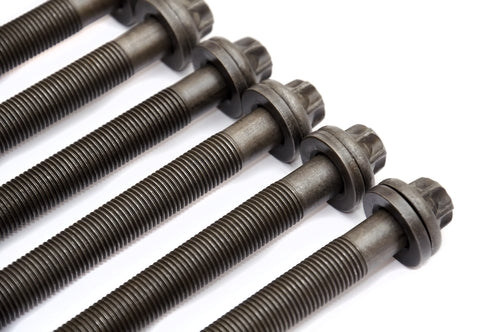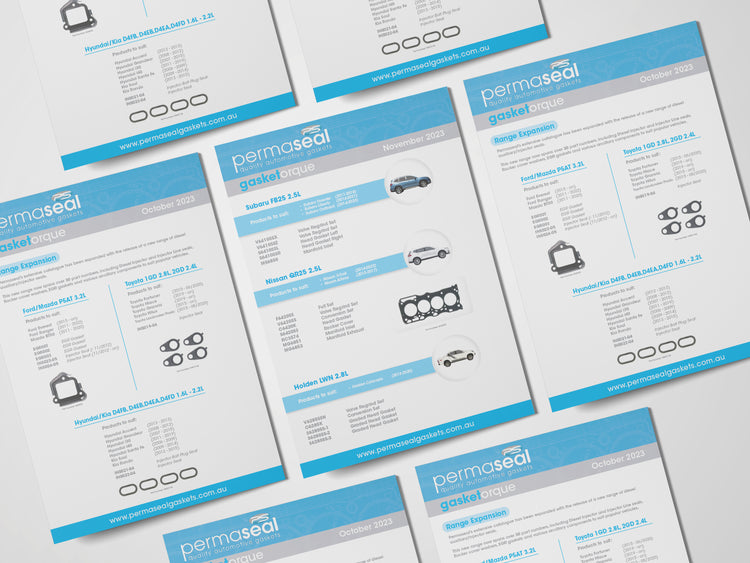
Head Bolts
Torque-to-yield bolts, also commonly referred to as angle torque or stretch bolts, are used in many of today's modern engines, predominantly for cylinder head bolts but also main bearing caps. Compared to conventional type bolts, torque to yield bolts offer the engine manufacturer several advantages including; greater flexibility of design, reductions in component costs, more accurate assembly and reliability of seal. Engines designed to utilise torque-to-yield (TTY) head bolts require fewer head bolts to achieve the desired clamping loads, than those using conventional bolts. With fewer bolts, the engine manufacturer has more flexibility in cylinder head and block design as well as reducing the cost of the engine.
While torque-to-yield bolts are attractive to the engine manufacturer, there are disadvantages to the engine repairer, which we all need to be aware of. For most of us, it would be unthinkable to replace a conventional head bolt unless the bolt was damaged; i.e. stripped threads, the bolt head was rounded off, the shank was severely corroded or pitted.
Conventional head bolts simply, just do not wear out. Torque to yield head bolts however, by the very nature of their design, do wear out and should never be reused.
Bolt Performance
Under the application of load, all bolts exhibit four main phases. The elastic phase, the plastic phase, the yield point and the shear point. In the elastic phase, a bolt will stretch under tension but return to its original length when the load is removed. As we continue to apply load, the bolt reaches the plastic phase from which it can no longer recover to its original length and is now permanently stretched. The point that separates the elastic phase from the plastic phase is called the yield point of the bolt. Finally, if we continue to apply load, the shear point is reached and the bolt material wastes and breaks. The chart below demonstrates these four phases.

|
Conventional Bolts
Conventional head bolts are tightened in a series of stages and in sequence to a predetermined torque setting. Given any set of bolts, each will be tightened to a slightly different loading as the torque wrench simply clicks off when the set resistance level is reached. The applied tension is well within the elastic phase of the bolt; i.e. the bolt stretches under load and then returns to its original length when loosened. No allowances are made for variances, such as higher resistance due to friction or thread damage or in the applied load of individual bolts within the engine set.
These variances and inaccuracies are well known by engine designers. The following two graphs show that when tightening a conventional bolt using a torque wrench, only 10% or 15% of the tightening force produces tension in the bolt. The remaining 85% to 90% of the tightening force is lost to friction.

|
It should also be noted that these figures are based on assembly with clean threads, with a light application of oil applied to the threads and the bearing surfaces of the bolt head. Dirty or damaged bolt threads can absorb enough of the total tightening force to result in a very low and insufficient clamping load being applied.
Torque-to-yield Head Bolts
Torque-to-yield head bolts are also tightened in a series of stages and in sequence, however, they are not tightened to a predetermined torque, they are tightened through a series of specified angles. This data is provided by the engine manufacturer and should always be adhered to. While the first step in the tightening process is normally stated as a torque figure, it is done only to provide a uniform baseline from which the true load is then applied. This is commonly referred to as a pre-load or snug torque.
A typical tightening specification would look as follows.
i. uniformly tighten in sequence in several passes to 78Nm
ii. tighten in sequence 90°
iii. tighten in sequence a further 90°
This procedure ensures that friction does not cause an uneven bolt loading and that the correct high tension is achieved every time during assembly. It is essential that a quality wrench, with an accurate angle gauge be used to achieve the correct angles of turn in the tightening process.
Unlike a conventional bolt, torque-to-yield bolts are tightened beyond their elastic range and past their yield point; i.e. past the point from which the bolt material can recover to its original length and into the plastic phase of the bolt material. The bolt is permanently stretched and it is for this reason they should not be reused. The reliability of these bolts once stretched is greatly reduced. If they are reused, they are permanently stretched further a second or third time. That is why you should never retorque, a torque-to-yield bolt.
Some engine manufacturers provide a measurement within which a bolt may be reused, however the age and history of the bolt is not taken into account. The bolt may well be within specification to pass a simple measurement test, but the bolt could be very close to its shear point. Only one failed bolt can result in serious combustion leakage. The cost of a new set of torque-to-yield bolts is well justified when compared to the costs of having to repair an engine for the second time because of insufficient clamping load due to bolt fatigue. Today almost all engine manufacturers are using torque-to-yield head bolts.
There are a variety of factors that will shorten the service life of a head gasket but lack of proper clamping load is certainly one of the leading contributors. Always ensure the bolt hole threads are clean prior to fitting. It is recommended that you do not use standard engineering thread taps for this purpose as torque-to-yield bolts are manufactured to finer tolerances. Standard engineering taps, in these applications, can remove too much material from threads, resulting in minimal thread contact reducing the amount of clamping load that is applied to the cylinder head. This can cause premature engine failure. An alternative is to use an old bolt, with a machined groove the length of the thread, that can achieve a satisfactory cleaning result. Always apply a light coating of oil to the threads and bearing surfaces of the bolt and have your torque wrench checked and calibrated every 12 months.


